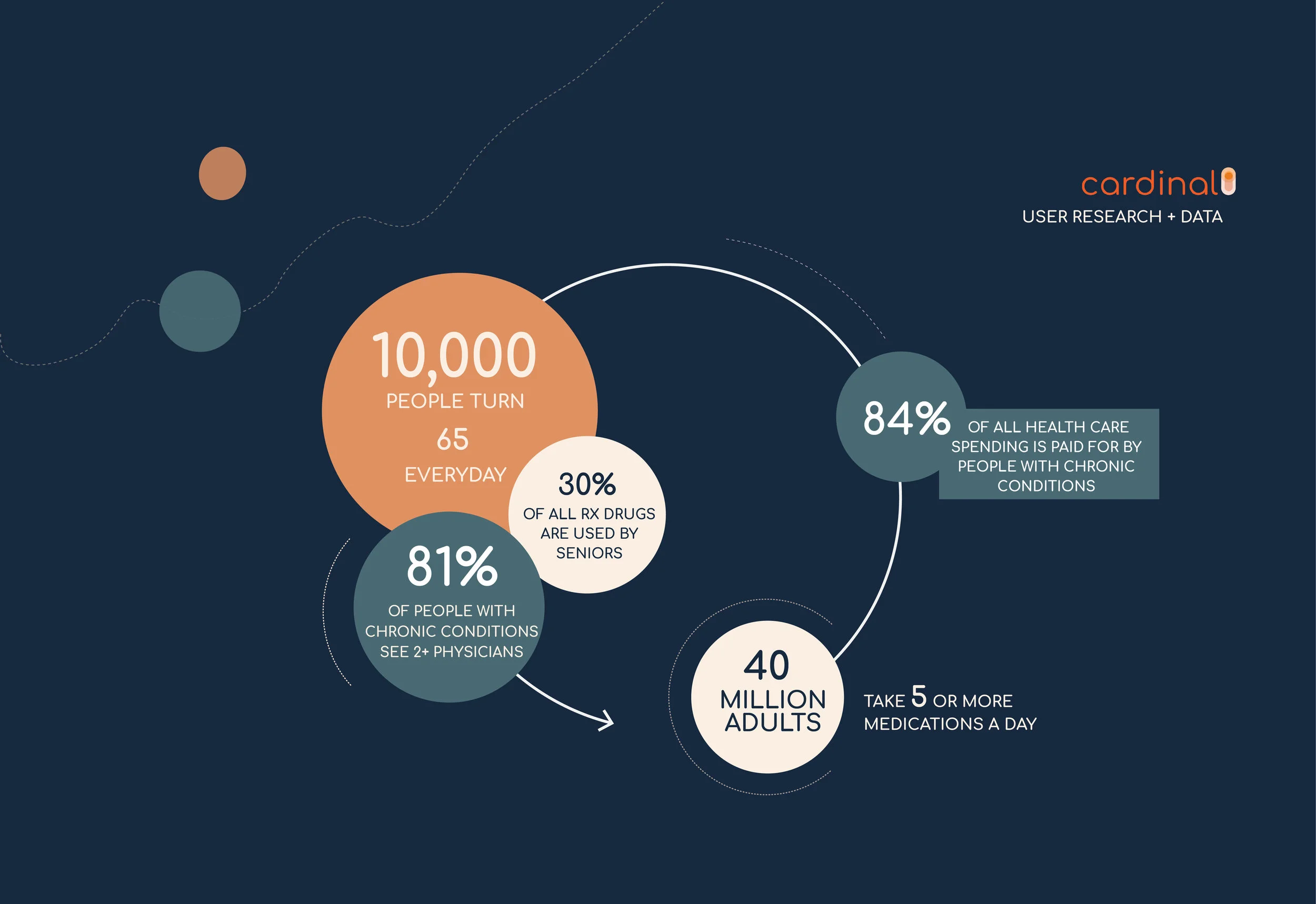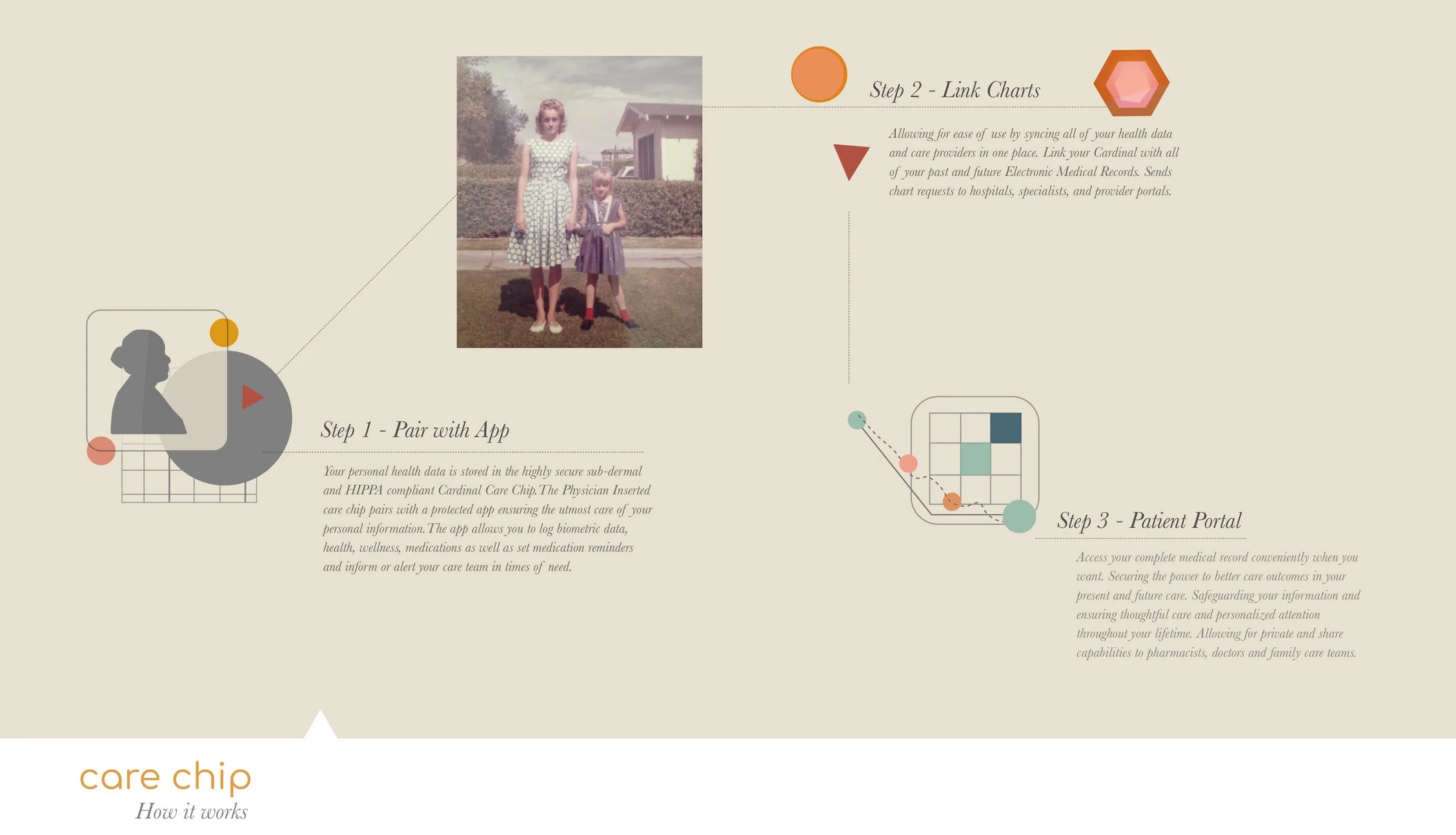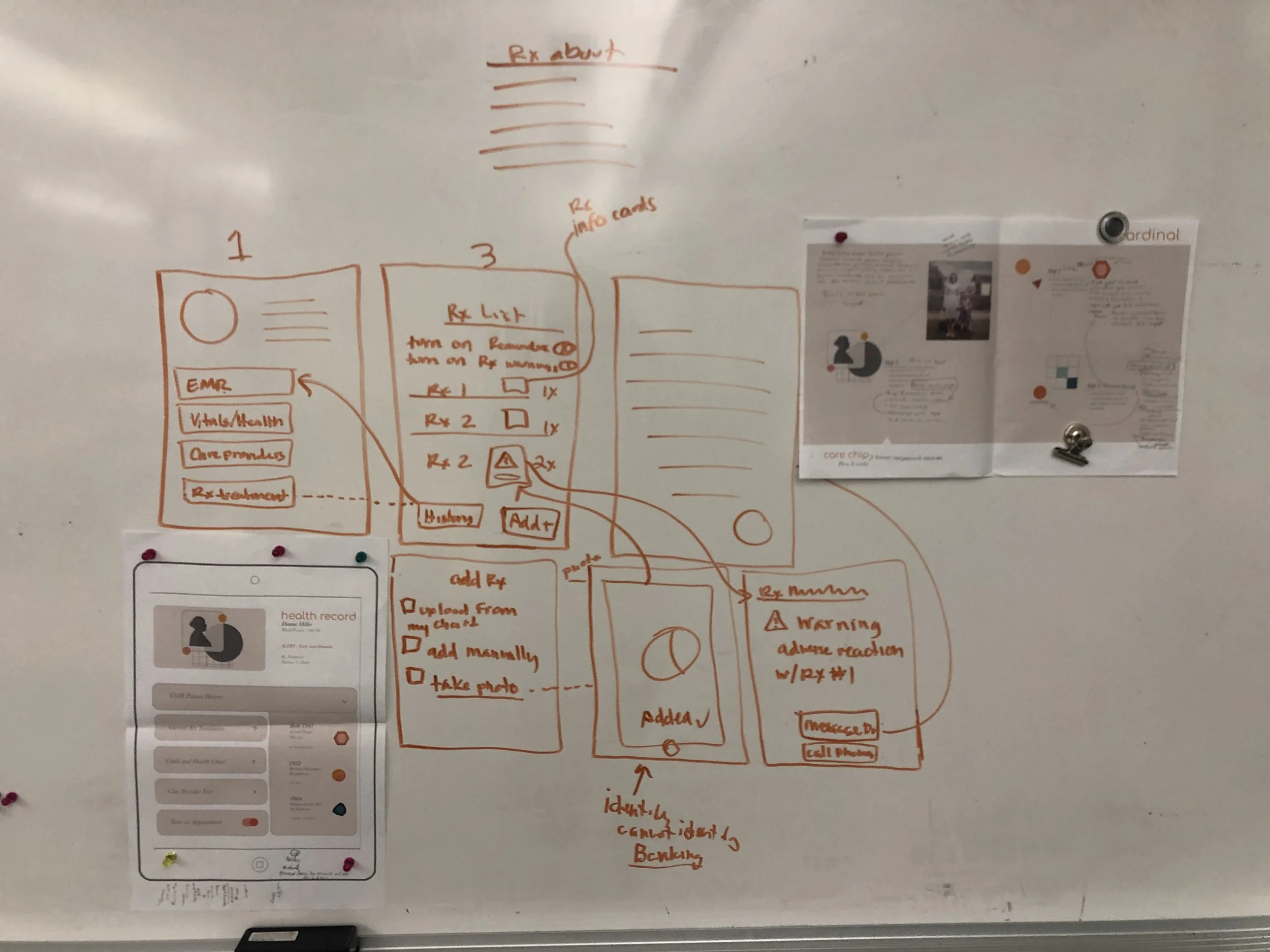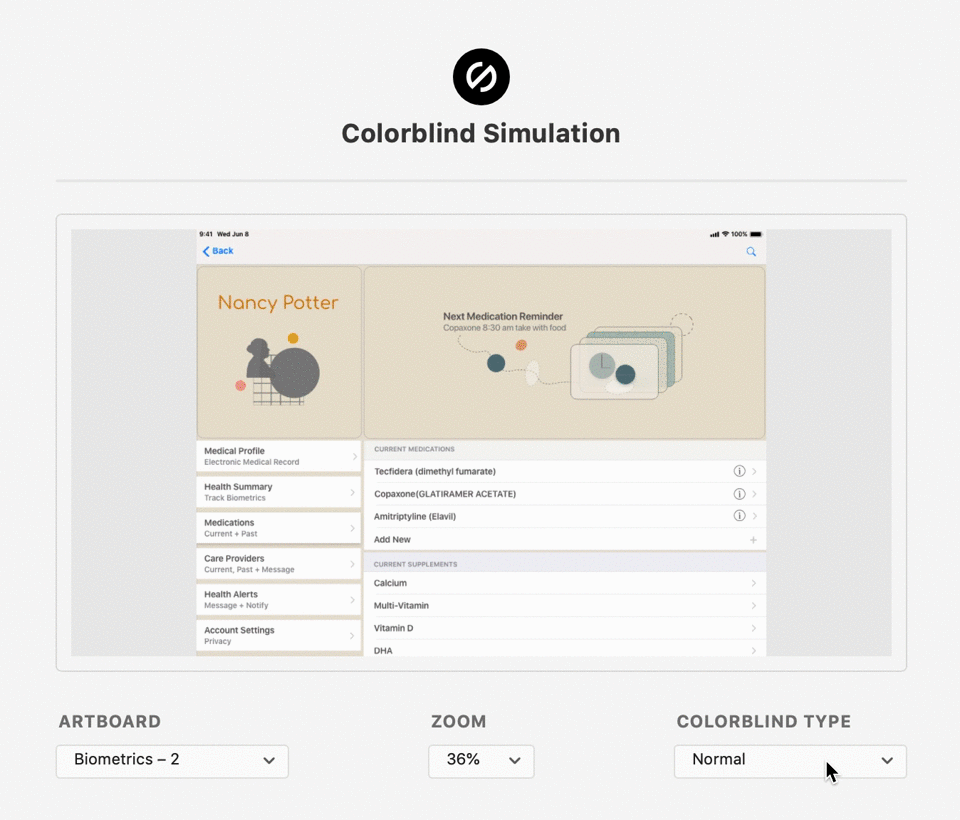“INFORMED, CONNECTED, WELLNESS APP”
Cardinal Health
Product Design | UX
MY ROLE: User Experience Design, Branding, Research, Visual Design , User Interface Design and Data Visualization.
TOOLS: Illustrator, InDesign, Photoshop,
Adobe XD and Sketch.
TIMEFRAME: 6 weeks
TEAMMATE: Tanya Sheremeta
BACKGROUND:
In 2015 the CDC passed legislation mandating the use of Electronic Medical Records. To meet the mandate and avoid penalties, the medical industry was forced to quickly overhaul its entire patient process. The rapid implementation of electronic medical record technology resulted in an increase in negative health outcomes for patients in vulnerable populations, such as seniors or those who have multiple health providers.
PROBLEM:
Different doctors, practices, and facilities implemented different electronic medical records systems that do not all seamlessly integrate with each other. This results in several common and costly problems that negatively impact patient outcomes. Two of the most common errors are providers failing to correctly match a patient with the correct medical records and/or medical providers assuming they have all the patient's medical records in one system when in fact other medical records exist in a different system(s). These common errors often result in higher medical costs and negative patient outcomes due to duplicate testing or procedures, delays in care, adverse drug interactions, and events like relapse or in the worst cases even death. Patients in vulnerable populations who often visit multiple facilities and providers are at a higher risk for these types of errors.
GOAL:
Empower vulnerable populations, especially seniors, experiencing chronic disorders, neurological issues, or dementia who routinely interface with multiple medical providers and are at risk of losing personal autonomy and independence. Allow caretakers to act as an advocate for loved ones and track medical needs.
SOLUTION:
Create a health tracking product and application that aggregates an individual's medical records, medications, and treatment plans, in a single data store, and provides a framework that empowers patients to improve the quality of their interactions with healthcare providers improving their health outcomes. By making a patient's entire medical history available in real time, we are empowering patients, their caretakers, and medical providers with all the data they to develop the best treatment plan for that patient and providing a mechanism for both the patient and medical provider to maintain continuity of patient care during coordinated care. This solution enables patients to have confidence in and maintain their autonomy of their medical history and care, while also freeing loved ones and caretakers from the burden of manually managing intake forms, medical records, coordinating care, tracking medications, and treatment plans.
RESEARCH + DISCOVERY
Above you can see our process whiteboard during the brainstorming and research phase.
FOCUS ON THE PATIENT:
Through our research, we identified a need for comprehensive health tracking via an intuitive and accessible interface that is secure, reliable, and supported on Android and iOS devices.
See MoSCoW here.
IDENTIFYING FEATURES:
This Rx worksheet developed by the CDC is the recommended tracking mechanism for patients who take multiple prescriptions. For large populations of people who take more than one medication, this tracking mechanism is difficult, if not impossible, to use. For example, people who are blind or have vision challenges, or people with disabilities who cannot write. With accessibility in mind, we designed a product, workflow, and an interface that was easier to use.
IDENTIFYING THE COMPETITOR:
We identified medical alert jewelry as our main competitor. Wearables have several weaknesses such as no standardized protocol for identification of the patient, they are often removed, and they carry limited patient information. See competitor SWOT here.
INFORMING DESIGN:
We designed our product to close feature gaps left open by our competitors like, actionable medical ID with a fixed passive ID tag to match patients to medical records, but more importantly we focused our efforts on building a platform to centralize people’s medical and health-related data to improve the quality of the care, maintain their autonomy and improve their health outcomes.
See product SWOT here.
OUTCOME:
“An informed connected wellness app that supports an optional implanted microchip helping people manage their health metrics and provide immediate access to patient record data.”
IS THE HUMAN BODY SAFE FOR A MICROCHIP?
This is no longer a hypothetical discussion. Treating and enhancing the human body with microchips is commonplace in restorative medicine. Complex computing devices are routinely implanted in the human body every day. These devices include nerve stimulators, cochlear implants, pacemakers, insulin pumps, IUDs, implantable birth-control rods, visual prostheses like artificial silicon retinas, and deep brain stimulators. These devices are designed to restore lost functionality and improve the lives of patients.
HOW IT WORKS:
The Physician Inserted sub-dermal care chip pairs with a HIPPA compliant app safeguarding personal health data. Cardinal allows patients to log biometric data, health, wellness, medications as well as set medication reminders and inform or alert care teams in times of need. Allowing for ease of use by aggregating all health data and care providers in one place. Patients are able to link past electronic medical records, add new ones and access complete medical records on the platform. The app also allows for private and share capabilities to pharmacists, doctors, family, and care teams.
THE BRAND
BUILDING TRUST WITH THE BRAND:
The brand voice is compassionate and empowering to patients, physicians, and caregivers. As the name suggests the brand is grounded in the belief that our health is of the greatest importance and receiving the best medical care is a fundamental human right. With this foundation the Cardinal brand was developed in a warm, caring, and human tone. We identified people want to feel cared for as a human and not just a patient number and designed the platform to deliver a personal, human, experiences.
You can see the brand attributes and guidelines here.
DEMOGRAPHICS:
Cardinal’s target audience is the aging population and those with multiple care providers. While we envision targeting different demographics in the future, we identified a product market fix among seniors and those with chronic conditions who see multiple care providers. These demographics often interact with medical providers who lack a complete picture of their medical care or are fearful of losing independence and autonomy as they routinely visit medical providers whom they often perceived as not caring for them personally and thus do not trust.
.
WHAT DOES THE PATIENT EXPERIENCE LOOK LIKE?
A patient will always be identifiable in an emergency situation even if they are unconscious or under duress. The chip can be scanned by care professionals and used to relay important medical details when linked to an online medical database accessible by the patient, care team and emergency contacts. Medical records are stored on the HIPPA compliant mobile or tablet app and emergency contacts are notified by Cardinal if or when a scan occurs. Privacy and sharing of access are granted by the patient.
USER PROFILE AND JOURNEY:
We follow Nancy’s Journey as a person and a patient. Nancy is a 63-year-old female with multiple health conditions. Her main goal is to maintain independence through her remaining life stages. Recently widowed, she saw the rapid decline of her partner and experience the need for both of them to advocate the best health care with multiple care providers. After needlessly undergoing the same test multiple times and a visit to the ER due to unanticipated but known Rx interactions, Nancy worried for her partner’s life as she realized the health care system was not designed to provide each provider with a complete picture of her husband's medical history. She quickly learned she would need to track medication, collate medical records, research treatment options, coordinate are herself to ensure her partner received the care he deserved. The User Journey below follows Nancy’s touch points with Cardinal.






























